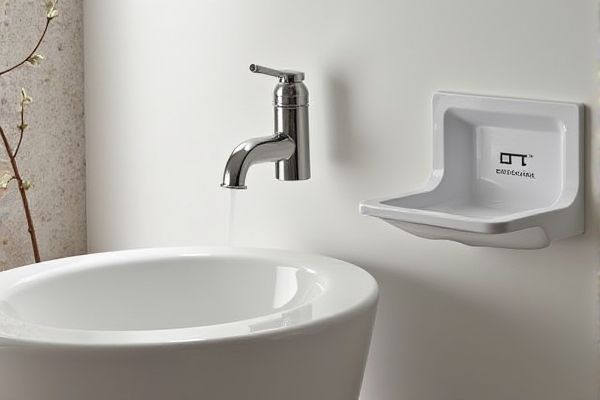
Wall-mount soap dishes offer easy installation and accessibility, fixing directly to the bathroom wall and saving counter space, while recessed soap dishes are built into the wall, providing a sleek, space-saving design that minimizes soap residue mess. Explore the rest of the article to discover which option best suits your bathroom's style and functionality needs.
Table of Comparison
| Feature | Wall-Mount Soap Dish | Recessed Soap Dish |
|---|---|---|
| Installation | Surface-mounted on wall; easier to install | Built into wall; requires wall modification |
| Space Efficiency | Takes up external wall space | Saves space; flush with wall surface |
| Durability | Exposed to accidental knocks | Protected within wall cavity |
| Maintenance | Easy to remove and clean | May require more effort for cleaning |
| Aesthetics | Visible, may protrude; varies by design | Sleek, minimalistic look |
| Cost | Lower installation cost | Higher installation cost due to wall work |
| Best Use Case | Ideal for rental spaces or easy upgrades | Best for permanent, modern bathroom designs |
Introduction to Soap Dish Types
Wall-mount soap dishes are external fixtures that attach directly to your bathroom wall, offering easy installation and accessibility. Recessed soap dishes are built into the wall cavity, providing a sleek, space-saving solution that blends seamlessly with your bathroom design. Choosing between the two depends on your preference for visibility, installation complexity, and available wall space.
Wall-Mount Soap Dish: Features and Design
Wall-mount soap dishes offer versatile installation options and often feature durable materials like stainless steel or ceramic, making them resistant to rust and easy to clean. Their protruding design allows for easy access and quick drainage, preventing soap from becoming soggy. Choosing a wall-mount soap dish can enhance Your bathroom's functionality while adding a stylish, space-saving solution.
Recessed Soap Dish: Features and Design
Recessed soap dishes are built into the wall cavity, providing a sleek, space-saving design that keeps counters clutter-free and enhances bathroom aesthetics. They typically feature waterproof materials such as ceramic or stainless steel, with drainage holes or sloped surfaces to prevent soap from becoming soggy. This integrated design minimizes cleaning effort and reduces soap residue buildup, making recessed soap dishes a durable and practical choice for modern bathrooms.
Aesthetic Appeal and Bathroom Decor
Wall-mount soap dishes offer a sleek, minimalist look that complements modern bathroom decor by projecting slightly from the wall, adding subtle depth and visual interest. Recessed soap dishes provide a seamless, built-in appearance that maintains clean lines and maximizes space, ideal for small or contemporary bathrooms seeking a clutter-free aesthetic. Both options enhance bathroom design, with wall-mounted styles creating a functional focal point and recessed designs achieving an integrated, streamlined finish.
Installation Requirements and Complexity
Wall-mount soap dishes require straightforward installation, typically involving screws drilled directly into the wall surface, making them suitable for most bathroom walls. Recessed soap dishes necessitate cutting a cavity into the wall, which demands precise measurements and professional skills to avoid damaging plumbing or electrical systems. Your choice should consider the wall material and your comfort with potentially more complex modifications when opting for a recessed option.
Space Utilization and Bathroom Layout
Wall-mount soap dishes maximize space by freeing up countertop and sink areas, making them ideal for small or compact bathrooms. Recessed soap dishes integrate directly into the wall, offering a sleek, built-in solution that maintains a streamlined bathroom layout without protruding elements. Both options enhance organization, but recessed designs optimize vertical space, creating a more open and less cluttered environment.
Cleaning and Maintenance Considerations
Wall-mount soap dishes offer easy access for routine cleaning since they protrude from the wall and can be wiped down without removal, minimizing soap residue buildup. Recessed soap dishes, embedded within the wall, tend to collect water and soap scum in corners, making them more challenging to maintain and requiring periodic deep cleaning to prevent mold or mildew. Your choice between the two should consider how much effort you want to spend on cleaning and maintaining a hygienic shower environment.
Durability and Material Options
Wall-mount soap dishes typically offer greater durability with materials like stainless steel, ceramic, and heavy-duty plastic, making them resistant to impacts and easy to replace. Recessed soap dishes often come in ceramic, glass, or tile-integrated designs, which provide a sleek look but may be more prone to chipping or cracking over time. Material choices for wall-mounted options tend to be broader, catering to both heavy use and design preferences, whereas recessed versions emphasize seamless integration with wall surfaces, influencing material rigidity and longevity.
Cost Comparison: Wall-Mount vs Recessed
Wall-mount soap dishes generally cost less upfront, with prices ranging from $10 to $30, making them budget-friendly for quick installation. Recessed soap dishes typically require more labor-intensive installation and construction work, causing overall expenses to rise to $50-$150 or more. Your choice depends on balancing initial costs with long-term durability and design preferences in your bathroom setup.
Choosing the Right Soap Dish for Your Bathroom
Wall-mount soap dishes offer easy installation and flexibility, making them ideal for renters or quick bathroom updates, while recessed soap dishes provide a sleek, space-saving design integrated into the wall, perfect for modern, minimalist aesthetics. Choosing between these options depends on bathroom layout, wall material, and preferred style, with wall-mounted models typically made from plastic or metal, and recessed ones often constructed from ceramic or glass. Prioritize moisture resistance and ease of cleaning to maintain hygiene and durability regardless of the soap dish type.
 homyna.com
homyna.com